Data is a godsend for marketers, helping us serve our audience with better, more relevant ads.
However, regardless of what we might think, consumers aren’t always fans of data-targeted advertising. According to the Pew Research Center, four in five Americans say the benefits they see from data collection are outweighed by the potential risks, while the same proportion admits they’re concerned about how brands are using their data.
Far from being excited about the prospect of seeing ads tailored to their preferences, they feel resigned to having little to no control over how their personal information is used.
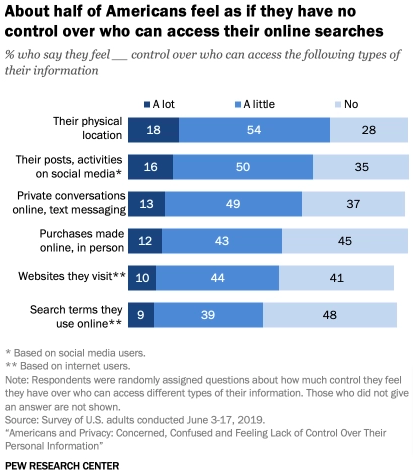
Theoretically, this is where AdChoices comes in. We’ll cover what AdChoices is all about, discuss its relevance to marketers and consumers, and review the initiative’s benefits and potential drawbacks.
What is AdChoices?
AdChoices is nothing new. It’s been around since late 2010, and its roots go back even further. To properly understand what it does and why it matters, it’s worth taking a quick detour into the program’s history.
Concerned about the implications of advertisers capturing vast quantities of consumer data with no checks or balances in place, the U.S. Federal Trade Commission (FTC) began an investigation into the practice in 2009.
This investigation ruled that consumer privacy should be protected through stricter regulation around data collection. However, rather than directly implementing these regulations, the FTC called on the ad industry to regulate itself.
As a result, some of the biggest names in advertising joined forces under the Digital Advertising Alliance’s banner to establish the Self-Regulatory Program for Online Behavioral Advertising, which oversaw the launch of AdChoices in October 2010. Since then, it’s also been rolled out in Canada and across Europe.
The idea was that, by giving consumers an easy way to identify when online advertising data is being collected or used, people would feel empowered to manage their data and assume some level of control over the types of ads they see.
Back in 2007 (three years before AdChoices was born), market research firm Yankelovich estimated the average city resident saw 5,000 ads every single day, and it’s probably safe to assume that number has grown significantly since then. Many of the ads you see today are part of AdChoices, given that the program’s members include major advertisers and ad networks like:
- AT&T
- Microsoft
- Procter & Gamble
- Taboola
- Yahoo!
You can identify those behavioral ads by looking out for the AdChoices icon, a lowercase “i” inside a triangle. It typically appears in the top-right corner of behavioral internet ads served based on your data:

Clicking the icon will tell you more about why you’ve seen that ad or how the website in question collects data. You’ll also have the opportunity to opt-out of behavioral ad targeting.
Why Is AdChoices Important to Marketers?
There are a couple of reasons why AdChoices is such a big deal for marketers and advertisers.
Firstly, it should be apparent why self-regulation is better for the ad industry than being forced to adhere to many potentially far more stringent, government-enforced measures.
Secondly, it helps improve the user experience by ensuring (at least in theory) consumers are only served with ads they want to see.
Why Is AdChoices Important to Users?
Given how many internet users are concerned they have no control over how their data is collected and used online, AdChoices is broadly a good thing.
Simply put, it gives consumers more input into the ads displayed to them. If you see an ad you don’t like, you can hit the AdChoices icon and request to stop seeing it.

You might have any number of reasons for not wanting to see an ad anymore. Maybe you don’t like the company in question for moral reasons. Maybe you have no interest in the product; you could have been looking for gift ideas for a friend or family member, but you bought something else and have no need for it yourself. Perhaps you disagree with the way it’s being advertised. Whatever the case, you can block it.
Some ad networks, including Google, also allow you to dig into why you’ve been served with a particular ad in the first place.
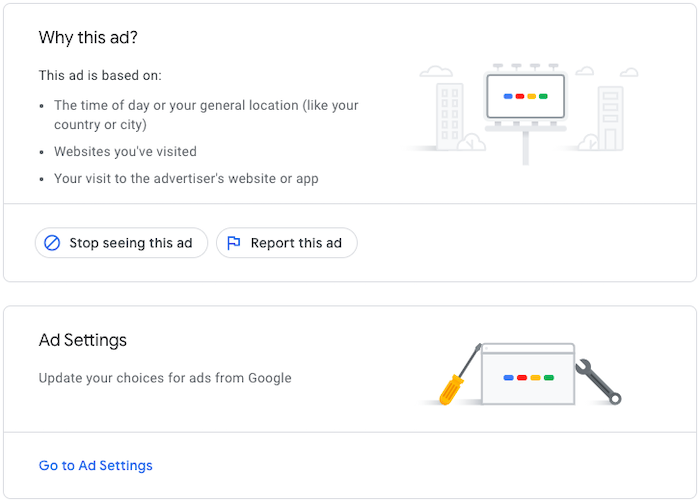
3 Reasons to Use AdChoices
I know what you’re thinking: “PPC is a massive source of sales for my business. Why would I give the people I’m targeting the chance to switch off my ads?”
Actually, there are some excellent reasons for handing greater control and choice to your potential customers. Here are three of the biggest:
1. AdChoices Helps Marketers Target Users With Relevant Ads
Sure, you don’t want everyone to opt-out of your behavioral ad campaigns. However, at the same time, do you want to keep targeting people who actively dislike seeing your ads?
If you’re paying on a CPM basis (that is, you’re paying per 1,000 impressions), any impressions that reach the wrong people are money down the drain.
Even if you’re paying per click, it’s not helpful when your ads are served to people who don’t want to see them. Best-case scenario, those people will like you even less. Worst-case, they’ll also start deliberately clicking your ads with no intention to buy, burning your budget and skewing your figures.
There’s a flip side to this, too.
By giving consumers the opportunity to block ads they don’t like, there’s an increased chance of your ads being seen by the right people. That, in turn, means your campaigns generate better results.
2. AdChoices Helps Build Trust With Consumers
As shown by those Pew Research Center figures I mentioned earlier, consumers don’t exactly love online ads.
This is best demonstrated by the seemingly inexorable growth of ad-blocking software. Today, over one-quarter of U.S. internet users block ads on their connected devices, and while the increase in adoption has been slow, it’s also been consistent.
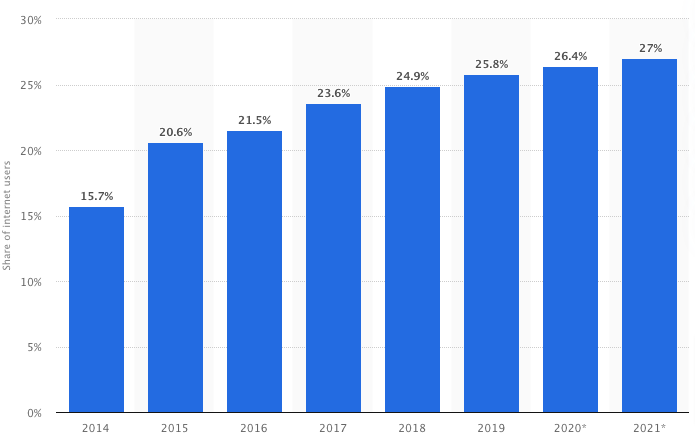
Universal uptake of ad blockers would clearly be a disaster for brands and marketers. Admittedly, that day may never come, but advertisers shouldn’t be complacent.
AdChoices could be the solution, or at least part of it. By raising awareness of the initiative and explaining how data is collected for ad targeting purposes, the online ad industry will appear more transparent and trustworthy to consumers.
This mitigates the risk of those consumers becoming frustrated with the number of targeted adverts they receive and resorting to ad-blocking technology.
3. AdChoices Helps Marketers Run More Effective Campaigns
You heard me right: By enrolling in AdChoices and enabling consumers to block your ads, you can improve campaign performance.
How? Because being more open about how and why you collect data may make your ads more effective.
A study published in the Journal of Consumer Research analyzed the impact of transparency on how campaigns perform. Of the authors’ learnings, I found these three points particularly interesting and relevant:
- Consumers don’t automatically hate having their data captured: Instead, they’re broadly happy with it, as long as the data was collected from within the site (rather than from a third party) and was provided by the user, rather than inferred by the advertiser.
- Transparency doesn’t guarantee success: If you leverage third-party data and infer things about the user, owning up to it won’t help you. In fact, revealing these “unacceptable information flows” can harm your ad effectiveness.
- Platform trust is tied to performance: When consumers trust your website and the way you utilize their data, ad performance increases. They’ll spend longer on your site, click more recommended items, and purchase more.
3 Possible Drawbacks of Adopting AdChoices
Data transparency can improve ad performance, and AdChoices offers the transparency consumers crave. In that case, surely signing up to AdChoices is a total no-brainer?
Unfortunately, as with so many things in marketing, it’s not quite that simple. While there’s plenty of upside to AdChoices, there are also some pretty substantial drawbacks, such as:
1. Lack of Awareness Around AdChoices
The biggest criticism around AdChoices is that not enough people know what it is. Presumably, you’re a little hazy yourself, or you wouldn’t be reading this article.
Given the financial clout behind the program’s backers, it’s hard to understand why awareness of AdChoices is so low. A poll conducted in 2013, three years after its introduction, found just six percent of consumers were aware of the AdChoices icon. By 2018, awareness of the program had reached almost 34 percent.
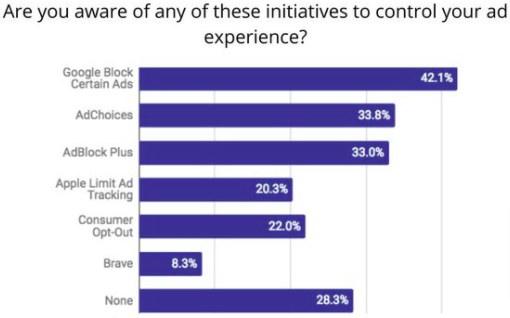
While that figure definitely represents a step in the right direction, it should be tempered by noting 28 percent of respondents said they weren’t familiar with any of the ad filtering or blocking programs presented to them, while 43 percent admitted they’d never used any of them.
Unless those numbers increase dramatically, it’s hard to see how AdChoices can achieve its stated aims of giving consumers greater control over their data.
2. Consumers Often Misunderstand the Purpose of AdChoices
Awareness isn’t the only issue. Even when consumers have heard of AdChoices, they often misunderstand why it exists.
As an example, in 2016, Advertising Standards Canada (ASC) received 283 complaints through the AdChoices platform, double the number from 2015.
That suggests the program was working as intended, right?
Sadly not. Of those complaints, only eight percent had anything to do with behavioral ads, which, if you remember, are the sole focus of the AdChoices initiative. In contrast, three-quarters were about different types of ads that weren’t targeted on data.
To make matters worse, of that tiny proportion of relevant complaints, most were from people who incorrectly believed opting out through AdChoices would stop them from seeing any online ads in the future. They contacted the ASC because they were annoyed ads were still being served to them.
AdChoices isn’t an ad blocker; it’s about seeing more relevant ads. For whatever reason, this message doesn’t seem to be getting through to consumers.
3. AdChoices Can Look Inconsistent
There are likely lots of reasons why consumers aren’t “getting” AdChoices, but it certainly doesn’t help that there’s so much inconsistency around the program and how the icon is implemented.
What do I mean by this?
See for yourself. First up, here’s an ad displaying the AdChoices icon in the top-right corner, but without the “X” icon next to it:
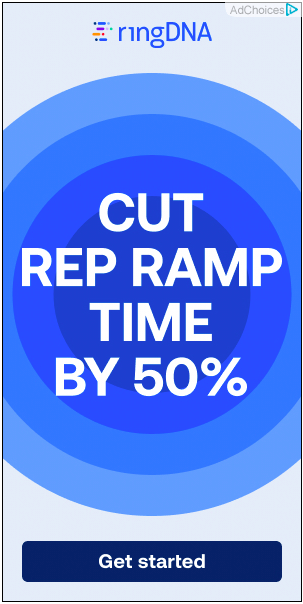
Next, here’s a different ad in which the AdChoices icon appears in the top-left instead:
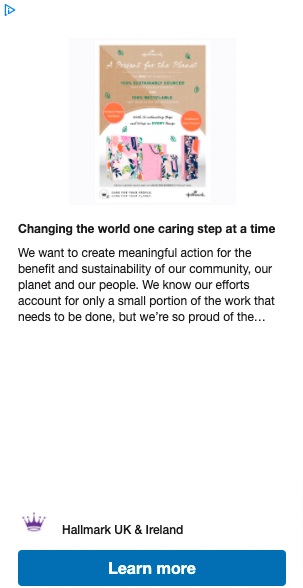
Even more confusingly, here are two separate ads for the same product, seen on the same website, within minutes of one another. These ads are more or less identical, yet one displays the AdChoices icon:

The other doesn’t:

This happens because different vendors and ad technology providers are responsible for serving ad impressions, and not all of those companies have joined AdChoices.
When this sort of inconsistency exists, how can we expect consumers to understand AdChoices and trust that it’s working for their benefit?
Conclusion
As you can see, there are some pretty significant concerns about the viability of AdChoices.
If it’s going to deliver its goals and make the world of behavioral ads better for consumers, it needs to be adopted by the vast majority of ad platforms and providers. Otherwise, it’s hard to imagine there’ll be much growth in awareness of the program or support for the objectives it’s trying to achieve.
That’s not to say the underlying principles of AdChoices are bad or wrong. Consumers clearly want greater control over their data and the way it’s used by advertisers.
However, with Apple, Google, and Mozilla taking steps to ditch the third-party cookies that power behavioral ads, the days of relying on this type of advertising could be numbered.
Maybe it’s time we give consumers what they want and turn to less invasive, more traditional tactics like contextual and keyword-based advertising?
What do you think about AdChoices? How would you cope without behavioral targeting?

See How My Agency Can Drive Massive Amounts of Traffic to Your Website
- SEO – unlock massive amounts of SEO traffic. See real results.
- Content Marketing – our team creates epic content that will get shared, get links, and attract traffic.
- Paid Media – effective paid strategies with clear ROI.

